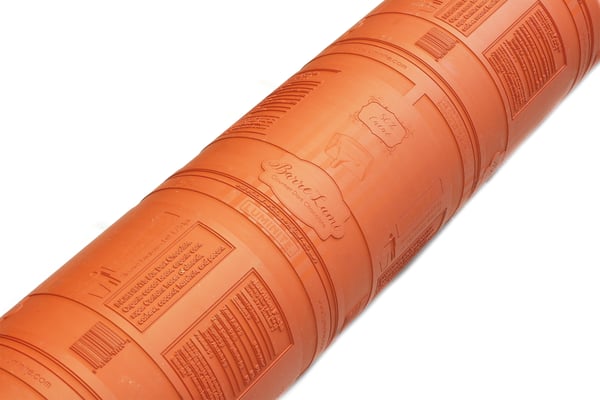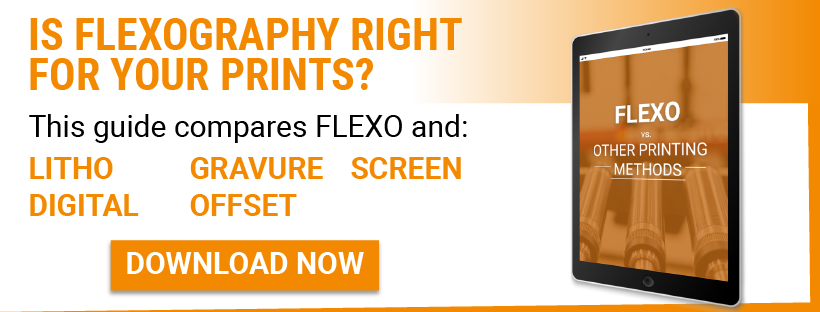Share this
Photopolymer & Elastomer in Flexo: Pros and Cons
by Luminite on Aug 12, 2022 4:10:00 PM

Elastomer blend or photopolymer: Which image carrier material will work best on a flexographic printing job?
Answer: It depends. It also matters to your bottom line.
So it’s important to know the difference to determine which applications call for which kind of image carrier.
Elastomer Blend Image Carriers: Advantages and Limitations
The term “blend” refers to polymers that, together, make up an elastomer image carrier. Cylindrical, seamless, and quite durable, the image carriers are laser-ablated to create the image to be printed.
Elastomer blend image carriers work well in a wide range of applications, including varnished or coated substrates, plastic, and metal.
Dot gain using elastomer image carriers is low, so they’re an excellent choice for a variety of substrates and products.
Elastomer image carriers have applications in printing jobs that involve these elements, among others:
- Long print runs
- Use of vibrant colors
- Use of adhesive or specialty inks
- Large-format designs
- Tight registration
However, one kind of elastomer image carrier doesn’t fit all situations. For the best results, you need to be sure your image carrier is made from the right blend of polymers.
Elastomer image carriers can also reduce waste. They won't swell or wear as quickly, so they are often reusable. Due to their durability, replacement image carriers do not have to be purchased as frequently.
In terms of limitations, elastomer image carriers do have a few. For example:
- When printing on corrugated, the elastomer can be hard enough to damage the flutes. However, this can be avoided with an optimized printing process, being mindful of the selected durometer and desired design.
- Depending on the substrate/ink combination, light vignettes may be difficult to produce.
Photopolymer Image Carriers: Advantages and Limitations
The image on photopolymer image carriers is created using ultraviolet light. They’re flat and can be mounted to the printing cylinder either when it’s manufactured or on the press.
Photopolymer image carriers can hold very fine lines by meeting tight tolerances. For jobs with high detail requirements, photopolymer image carriers are often a good choice.
If a job calls for fast turnaround, one-time short runs, and frequent design changes, photopolymer image carriers are likely the way to go.
However, photopolymer image carriers tend to not withstand aggressive inks. They also tend to produce distorted images and image breaks, as well as the inevitable seam.
Photopolymer plates can be easily damaged during mounting, and can also be prone to lifting.
What The Experts Say
One study on flexographic printing suggests that “the elastomer printing system laid down more ink and produced sharper printing than the photopolymer printing system.”
Further, the study indicates that “the elastomer printing system showed greater solid ink densities for the solvent and aqueous ink printing conditions, while the photopolymer printing system showed higher values in the ultraviolet ink printing conditions. Results across conditions also revealed that the elastomer printing system produced stronger opacities, larger print contrasts, smaller minimum dots, finer lines, and smaller type that the photopolymer printing system.”
This information seems to suggest that elastomer image carriers are “better” than photopolymer image carriers. However, the decisions still come down to application. When the right answer eludes you, it can probably be found with a reputable image carrier manufacturer.

(Editor's note: This blog was originally published in September 2019 and was updated in August 2022 to reflect updated information.)
Share this
- Flexographic Printing (81)
- Image Carrier (28)
- Elastomer sleeves (27)
- Ink Transfer (25)
- Quality (22)
- Flexo sleeve (20)
- News (18)
- printing defects (18)
- flexo printing defects (17)
- sustainability (13)
- Flexo Troubleshooting (12)
- Ink (12)
- Digital Printing (10)
- Flexo 101 (10)
- Flexo Inks, (9)
- Anilox (7)
- Blister Packaging (7)
- Cost (6)
- print misregistration (6)
- regulations (6)
- Corrugated Printing (4)
- pinholing (4)
- "Tradeshow (3)
- Digital Flexo (3)
- Gravure Printing (3)
- Insider (3)
- Load-N-Lok (3)
- Wide Web (3)
- direct laser engraving (3)
- flexo-equipment-accessories (3)
- gear marks (3)
- halo (3)
- testing (3)
- Narrow Web (2)
- bridging (2)
- feathering (2)
- filling in (2)
- mottled image (2)
- pressure (2)
- Labelexpo (1)
- dirty prints (1)
- doughnuts (1)
- embossing (1)
- kiss impression (1)
- October 2023 (2)
- September 2023 (1)
- August 2023 (1)
- July 2023 (3)
- June 2023 (1)
- May 2023 (5)
- April 2023 (1)
- March 2023 (2)
- February 2023 (1)
- January 2023 (3)
- December 2022 (1)
- October 2022 (3)
- September 2022 (2)
- August 2022 (2)
- July 2022 (3)
- May 2022 (1)
- April 2022 (4)
- March 2022 (2)
- February 2022 (5)
- January 2022 (7)
- December 2021 (1)
- November 2021 (3)
- October 2021 (2)
- September 2021 (1)
- August 2021 (1)
- July 2021 (3)
- June 2021 (1)
- May 2021 (4)
- April 2021 (4)
- March 2021 (4)
- February 2021 (2)
- December 2020 (1)
- November 2020 (1)
- October 2020 (2)
- September 2020 (1)
- August 2020 (3)
- July 2020 (2)
- June 2020 (3)
- May 2020 (1)
- April 2020 (1)
- November 2019 (3)
- October 2019 (1)
- August 2019 (1)
- July 2019 (1)
- April 2019 (1)
- March 2019 (1)
- January 2019 (1)
- October 2018 (2)
- August 2018 (1)
- July 2018 (1)
- June 2018 (1)
- February 2018 (2)
- October 2017 (1)
- September 2017 (2)
- January 2016 (1)
- February 2015 (1)
- January 2015 (1)
- December 2014 (2)
- September 2014 (1)
- February 2014 (1)
- January 2014 (1)
- December 2013 (3)
- October 2013 (1)
- September 2013 (1)
- June 2013 (1)
- January 2013 (1)

No Comments Yet
Let us know what you think